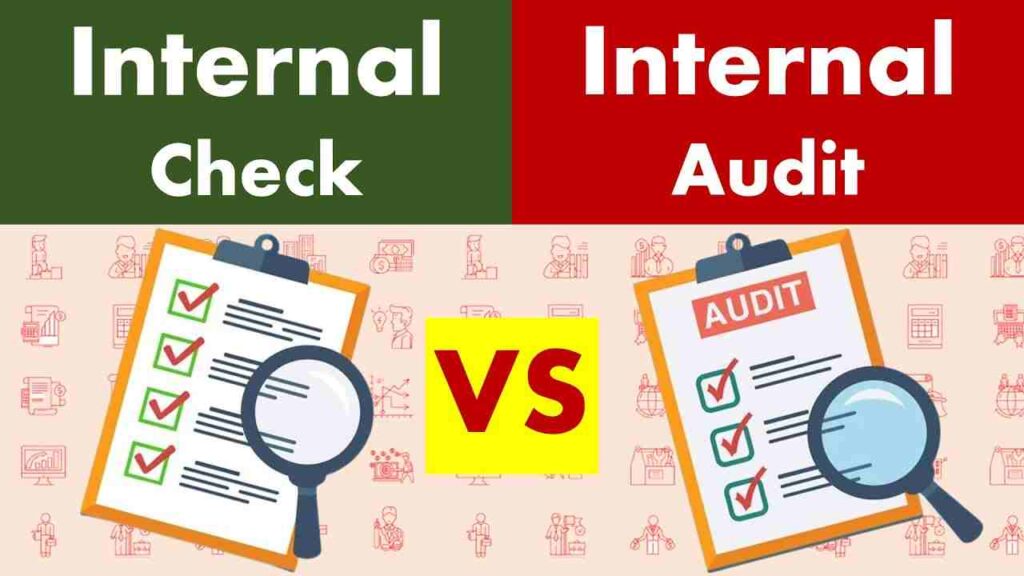
Explore Key 15 Difference between Internal check and Internal control
In the realm of organizational management and financial auditing, the concepts of internal check and internal control play vital roles in ensuring the integrity, efficiency, and reliability of processes. Distinguishing between these two concepts is crucial as they serve distinct but interrelated purposes. Here are 15 key difference between internal check and internal control, shedding light on their unique characteristics:
15 Difference between Internal check and Internal control
Nature: Internal checks are primarily focused on how responsibilities are divided within an organisation, making sure that no one person has excessive control over a process. Internal control, on the other hand, covers a wider range of systems, policies, and procedures that are intended to protect assets, ensure accurate financial reporting, and enhance operational effectiveness.
Focus: Internal checks use cross-checks, reconciliations, and verifications to find errors, irregularities, or fraud. Internal control, on the other hand, places more of an emphasis on prevention than on detection and aims to set up procedures that reduce the possibility of errors or irregularities occurring in the first place.
Scope: Internal checks usually pertain to regular, everyday transactions and concentrate on the accuracy of records, mathematical computations, and timely task completion. Contrarily, internal control covers a wider range of topics, including risk management, compliance, and strategic planning.
Implementation: Simple steps like job rotation, supervision, and independent transaction verification can be used to implement internal checks. Being a comprehensive system, internal control necessitates a structured approach that includes policies, procedures, internal audits, and periodic evaluations.
Objectives: Internal checks are primarily intended to identify and stop errors or fraud by introducing checks and balances. On the other hand, internal control works towards a variety of goals, such as protecting assets, guaranteeing compliance with laws and regulations, and improving operational effectiveness.
Accountability: Internal checks encourage individual accountability by delegating particular tasks to various people and highlighting the importance of third-party verification. Internal control establishes a system of checks and balances across various functions and levels, focusing on overall accountability within the organisation.
Documentation: Internal checks frequently rely on ad hoc documentation, such as instructions, policies, and checklists. Policies, procedures, manuals, and control matrices are all forms of formal documentation needed for internal control.
Risk assessment: Internal check may not specifically address risk assessment because its main objectives are accuracy and verification. On the other hand, internal control entails the recognition and evaluation of risks, enabling the application of suitable controls.
Review frequency: Internal checks frequently entail continuous, ongoing examinations and confirmations of transactions as they take place. To determine the effectiveness of control measures and pinpoint areas for improvement, internal control includes routine reviews and evaluations.
Cost-effectiveness: Since internal checks mostly involve changing procedures and stepping up supervision, they are typically less expensive to implement. The resources needed for internal control may include investments in infrastructure, training, specialised personnel, and technology.
Legal compliance: Internal check’s primary goal is error detection, though it may incidentally contribute to compliance. Internal control gives legal compliance a higher priority, ensuring that the organisation complies with all applicable laws, rules, and industry standards.
Fraud prevention: By introducing separation of duties and independent verification, internal check provides a fundamental level of fraud prevention. By incorporating measures like internal audits, fraud risk assessments, and whistleblowing mechanisms, internal control strengthens fraud prevention.
External reporting: Since internal processes are the primary focus of internal check, external reporting is not a direct concern. By implementing controls over the preparation and disclosure of financial statements, internal control ensures accurate and trustworthy external financial reporting.
Scalability: In small organisations, where segregation of duties and supervision can be accomplished with few resources, internal check is relatively simpler to implement. The size and complexity of an organization’s operations should not affect how internal control scales and adapts.
Management responsibility: Internal control primarily places the onus of diligently completing assigned tasks on the shoulders of individual employees. Management must take a proactive role in creating, maintaining, and enforcing the control environment as part of internal control.
Organisations can strengthen their internal governance, reduce risks, and guarantee the overall integrity and effectiveness of their operations by adopting appropriate strategies by understanding the key difference between internal check and internal control.
Also Read: Explore Key 15 Difference between Galvanometer and Ammeter